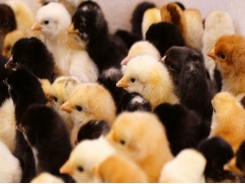Study shows efficiency of BSF and bacteria for producing larvae as feedstuff and fertilizer

Using black soldier fly (BSF) larvae and bacteria, poultry producers may be able to reduce chicken manure and generate large amounts of feed proteins, say researchers.
An international team of researchers from the US, the Netherlands, Italy and China explored the potential for turning chicken manure into a feed protein using black soldier fly larvae (BSFL) and functional bacteria.
“We tried to develop an efficient and high-value co-conversion technology of chicken manure by BSFL and bacteria in a poultry farm,” the researchers said. “Our aim was to maximize BSFL harvest and waste mass reduction by using synergistic bacteria in the first stage and shorten the maturity time through inoculation with a decomposing agent to promote aerobic fermentation in the second stage.”
The researchers tracked conversion rate by the larvae, how quickly the amount of manure was reduced, chemical and physical properties, the occurrence of phytotoxicity and amount of microbial enzymes, they said.
In the study, researchers found that using black soldier fly larvae (BSFL) and Bacillus subtilis they were able to recycle the manure more quickly and generate a larger amount of fly larvae for use in animal feed.
“Black soldier fly larvae (BSFL) conversion rate and chicken manure reduction rate were improved by BSFL and B. subtilis BSF-CL co-conversion,” they said. “The incremental percentage of BSFL weight, BSFL conversion rate and chicken manure reduction rate was 15.9%, 12.7% and 13.4%, respectively.”
“To our knowledge, it is shown for the first time that co-conversion of chicken manure by composting through BSFL and their synergistic bacteria, which is high-efficient and need less time,” they said. “The process will be a new strategy in chicken manure and other organic wastes management.”
Why fly larvae and bacteria?
The production of poultry has increased with the rise in demand for meat and eggs, the researcher said. However, a large amount of chicken manure also has been generated.
Poultry manure has a large amount of biodegradable organic matter, nutrients and pathogens, they said. If improperly managed it can become a source of pollution.
To kill pathogens and support crop growth, manure is often composted, they said. “However, the low C/N ratio, high moisture content, nasty odor, long decomposition period, nutrient loss, and the formation of phytotoxic compounds have become challenges for current composting methods,” they added.
Other ingredients like sawdust or rice chaff can be added to improve composting efforts, the researchers said. But they are becoming increasingly expensive and alternative means of converting chicken manure into compost are needed.
Many insects are able to degrade organic waste into nutrients, they said. The black soldier fly (Hermetia illucens), which can be located in decaying organic wastes including animal manure and plant material, also generates antimicrobial peptide activity against pathogens found in waste.
“BSF not only reduces the accumulation of manure and the nasty smell, it also inhibits the proliferation of house flies (Zheng et al., 2013),” the researchers said. “These processes greatly reduce environmental impact caused by livestock manure.”
The Wuhan strain of BSF was found to be able to reduce dry matter more than other strains of the fly, they said. Bacteria found in the gut of the fly also help boost the weight of pre-pupae and pupae and reduce the number of days needed to move from hatching to the pre-pupal stage.
“Therefore, BSFL can be used as animal feed and for biodiesel production,” they said. “The residue of the organic waste is a suitable substrate for aerobic fermentation during composting.”
Aerobic fermentation, or composting, increases the rate of decomposition for organic debris and adding microorganisms at the right time also can reduce the time decomposition takes, they said. “However, not much is known about the Insect-Bacteria-Manure digestion system in reducing manure pollution,” they added.
Methods and materials
In the feed protein production trial, 1,000 kg of chicken manure was inoculated with 1m 6-day-old BSFL and Bacillus subtilis (BSF-CL) for a 13-day period, the researchers said. The process was followed by an 11 day aerobic fermentation period where use of a decomposing agent was tested.
The results of the combined trial were measured against a control manure that had added BSFL but did not have the added bacteria, they said. Larvae were removed from the conversion system and the reside manure was composted in multiple piles.
Half of the piles, including some that had been previously inoculated with the BSFL and the bacteria, were dosed with a decomposing agent (DAITP) while the remaining piles had water added (WP).
Samples were collected daily from each manure pool and from each compost pile, they said.
Results
Overall, the manure inoculated with both BSFL and bacteria outperformed the control, the researchers said.
“The results of the co-conversion by BSFL and synergistic bacteria indicated that fresh chicken manure co-converted by BSFL and B. subtilis BSF-CL inoculums, can rapidly decrease accumulated chicken manure,” they said. “Also more mature larvae could be harvested as a protein source.”
The inoculated manure generated a larger amount of animal feed protein in terms of BSFL, they said. The trial manure produced 93.2kg of fresh larvae compared to 80.4kg generated in the control manure.
The rate of chicken manure reduction for the BSF-CL sample was 40.5% compared to 35.8% in the control, they said. “The weight of BSFL increased by 15.9%, BSFL conversion rate increased by 12.7%, and chicken manure reduction rate increased by 13.4% compared to the control,” they added.
Additionally, the composted residue, which had the added decomposing agent, had a higher maturity compared to the control after 11 days and maintained a higher temperature needed for pathogen elimination, the researchers said. “The activity patterns of different enzymes further indicated that its production was more mature and stable than that of the no decomposing agent group,” they added.
Source: Journal of Environmental Management
Authors: X Xiao, L Mazza, Y Yu, M Cai, L Zheng, J Tomberlin, J Yu, A van Huis, Z Yu, S Fasulo, J Zhang
Có thể bạn quan tâm
Phần mềm

Phối trộn thức ăn chăn nuôi

Pha dung dịch thủy canh

Định mức cho tôm ăn

Phối trộn phân bón NPK

Xác định tỷ lệ tôm sống

Chuyển đổi đơn vị phân bón

Xác định công suất sục khí

Chuyển đổi đơn vị tôm

Tính diện tích nhà kính

Tính thể tích ao hồ




 Broiler lighting, insect feeds focus of new research…
Broiler lighting, insect feeds focus of new research…  Stress may affect gender ratio of poultry offspring
Stress may affect gender ratio of poultry offspring